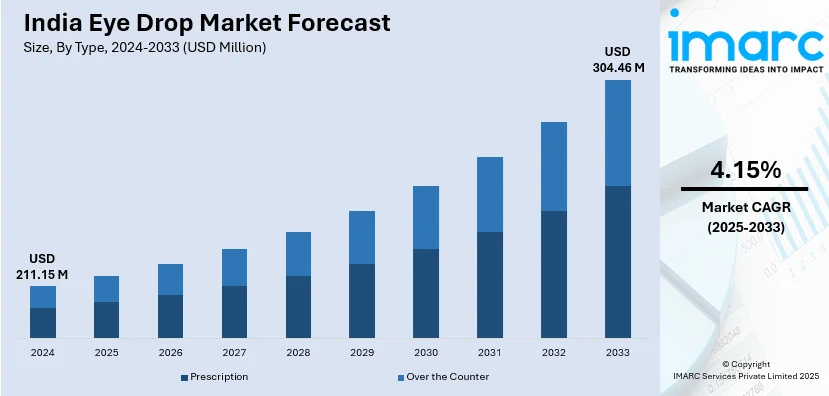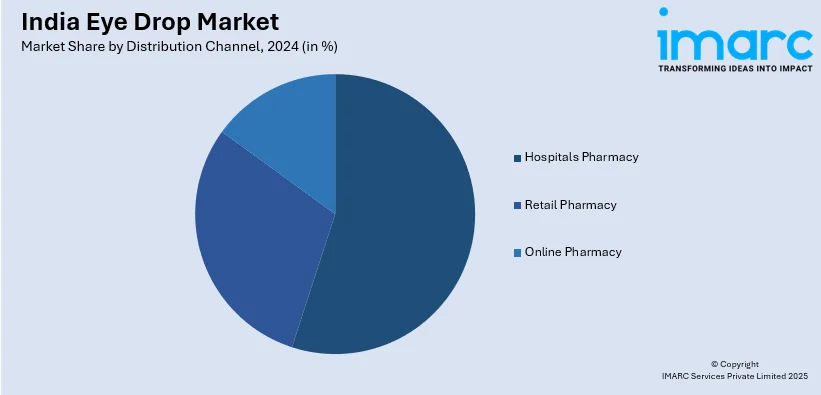
India Eye Drop Market Size, Share, Trends and Forecast by Type, Drug Class, Disease Indication, Distribution Channel, and Region, 2025-2033
India Eye Drop Market Overview:
The India eye drop market size reached USD 211.15 Million in 2024. Looking forward, IMARC Group expects the market to reach USD 304.46 Million by 2033, exhibiting a growth rate (CAGR) of 4.15% during 2025-2033. The rising prevalence of eye disorders, increasing screen time, and a growing aging population are driving the India eye drop market share. Additionally, expanding healthcare infrastructure and government initiatives are improving access to ophthalmic treatments, further catalyzing demand for prescription and over the counter (OTC) eye drops.
|
Report Attribute
|
Key Statistics
|
|---|---|
|
Base Year
|
2024 |
|
Forecast Years
|
2025-2033
|
|
Historical Years
|
2019-2024
|
| Market Size in 2024 | USD 211.15 Million |
| Market Forecast in 2033 | USD 304.46 Million |
| Market Growth Rate 2025-2033 | 4.15% |
India Eye Drop Market Trends:
Growing Aging Population
Elderly individuals are more prone to age-related eye conditions such as cataracts, glaucoma, and macular degeneration. These conditions require continuous management using medicated eye drops for treatment and symptom relief. With age, natural tear production decreases, leading to a higher prevalence of dry eye syndrome. Lubricating and artificial tear eye drops are widely used to alleviate discomfort and maintain eye health. Many seniors experience increased intraocular pressure, necessitating prescription eye drops for glaucoma management and vision preservation. Post-surgical eye care for cataract patients also contributes to the rising demand for specialized eye drops. The rising life expectancy is increasing the elderly population, further accelerating the India eye drop market growth. In March 2024, Roche launched Vabysmo in India to treat neovascular age-related macular degeneration (nAMD) and diabetic macular edema (DME). This bispecific antibody targets Ang-2 and VEGF-A, reducing injection frequency and improving vision outcomes, enhancing retinal disease treatment accessibility. Growing awareness about geriatric eye health is prompting more regular checkups and ophthalmologist-recommended eye drop usage. Government healthcare initiatives focusing on senior citizens are supporting access to affordable ophthalmic treatments. Pharmaceutical advancements are introducing preservative-free and herbal eye drops, catering to the needs of elderly patients.

To get more information on this market, Request Sample
Rising Prevalence of Eye Disorders
The growing incidences of eye illnesses is significantly influencing the India eye drop market outlook. Increasing cases of dry eye syndrome, conjunctivitis, glaucoma, and cataracts are leading to higher demand for eye drops. Many individuals suffer from eye infections and allergies due to pollution and environmental factors. India accounts for approximately 25% of the world's visually impaired population, highlighting the urgent need for effective eye care solutions. Eye drops are essential for managing redness, irritation, and bacterial or viral infections effectively. The growing diabetic population is also contributing to higher cases of diabetic retinopathy and related conditions. Nearly 13% of diabetic individuals experience diabetic retinopathy, increasing the demand for specialized eye drops to manage intraocular pressure, inflammation, and post-surgical eye care. Prolonged screen exposure is further increasing the occurrence of digital eye strain and fatigue. Lubricating and artificial tear drops are widely used to alleviate dryness and discomfort caused by screens. Rising awareness about early diagnosis and treatment is encouraging people to opt for medicated eye drops.
India Eye Drop Market Segmentation:
IMARC Group provides an analysis of the key trends in each segment of the market, along with forecasts at the regional level for 2025-2033. Our report has categorized the market based on type, drug class, disease indication, and distribution channel.
Type Insights:
- Prescription
- Over the Counter
The report has provided a detailed breakup and analysis of the market based on the type. This includes prescription, and over the counter.
Drug Class Insights:
- Antiallergy
- Anti-Inflammatory
- Antiglaucoma
- Anti-VEGF
- Others
A detailed breakup and analysis of the market based on the drug class have also been provided in the report. This includes antiallergy, anti-inflammatory, antiglaucoma, anti-VEGF, and others.
Disease Indication Insights:
- Dry Eye Diseases
- Glaucoma
- Eye Allergy
- Eye Infections
- Retinal Disorders
- Others
The report has provided a detailed breakup and analysis of the market based on the disease indication. This includes dry eye diseases, glaucoma, eye allergy, eye infections, retinal disorders, and others.
Distribution Channel Insights:

- Hospitals Pharmacy
- Retail Pharmacy
- Online Pharmacy
A detailed breakup and analysis of the market based on the distribution channel have also been provided in the report. This includes hospitals pharmacy, retail pharmacy, and online pharmacy.
Regional Insights:
- North India
- South India
- East India
- West India
The report has also provided a comprehensive analysis of all the major regional markets, which include North India, South India, East India, and West India.
Competitive Landscape:
The market research report has also provided a comprehensive analysis of the competitive landscape. Competitive analysis such as market structure, key player positioning, top winning strategies, competitive dashboard, and company evaluation quadrant has been covered in the report. Also, detailed profiles of all major companies have been provided.
India Eye Drop Market News:
- In September 2024, Entod Pharmaceuticals launched PresVu, an eye drop containing 1.25% pilocarpine hydrochloride, to treat presbyopia, an age-related vision condition affecting those over 40. Approved by the Drug Controller General of India, PresVu offers a non-surgical alternative to reading glasses, with effects starting within 15 minutes and lasting 6 to 10 hours.
India Eye Drop Market Report Coverage:
| Report Features | Details |
|---|---|
| Base Year of the Analysis | 2024 |
| Historical Period | 2019-2024 |
| Forecast Period | 2025-2033 |
| Units | Million USD |
| Scope of the Report |
Exploration of Historical Trends and Market Outlook, Industry Catalysts and Challenges, Segment-Wise Historical and Future Market Assessment:
|
| Types Covered | Prescription, Over the Counter |
| Drug Classes Covered | Antiallergy, Anti-Inflammatory, Antiglaucoma, Anti-VEGF, Others |
| Disease Indications Covered | Dry Eye Diseases, Glaucoma, Eye Allergy, Eye Infections, Retinal Disorders, Others |
| Distribution Channels Covered | Hospitals Pharmacy, Retail Pharmacy, Online Pharmacy |
| Regions Covered | North India, South India, East India, West India |
| Customization Scope | 10% Free Customization |
| Post-Sale Analyst Support | 10-12 Weeks |
| Delivery Format | PDF and Excel through Email (We can also provide the editable version of the report in PPT/Word format on special request) |
Key Questions Answered in This Report:
- How has the India eye drop market performed so far and how will it perform in the coming years?
- What is the breakup of the India eye drop market on the basis of type?
- What is the breakup of the India eye drop market on the basis of drug class?
- What is the breakup of the India eye drop market on the basis of disease indication?
- What is the breakup of the India eye drop market on the basis of distribution channel?
- What are the various stages in the value chain of the India eye drop market?
- What are the key driving factors and challenges in the India eye drop market?
- What is the structure of the India eye drop market and who are the key players?
- What is the degree of competition in the India eye drop market?
Key Benefits for Stakeholders:
- IMARC’s industry report offers a comprehensive quantitative analysis of various market segments, historical and current market trends, market forecasts, and dynamics of the India eye drop market from 2019-2033.
- The research report provides the latest information on the market drivers, challenges, and opportunities in the India eye drop market.
- Porter's five forces analysis assist stakeholders in assessing the impact of new entrants, competitive rivalry, supplier power, buyer power, and the threat of substitution. It helps stakeholders to analyze the level of competition within the India eye drop industry and its attractiveness.
- Competitive landscape allows stakeholders to understand their competitive environment and provides an insight into the current positions of key players in the market.
Need more help?
- Speak to our experienced analysts for insights on the current market scenarios.
- Include additional segments and countries to customize the report as per your requirement.
- Gain an unparalleled competitive advantage in your domain by understanding how to utilize the report and positively impacting your operations and revenue.
- For further assistance, please connect with our analysts.
 Request Customization
Request Customization
 Speak to an Analyst
Speak to an Analyst
 Request Brochure
Request Brochure
 Inquire Before Buying
Inquire Before Buying




.webp)




.webp)












